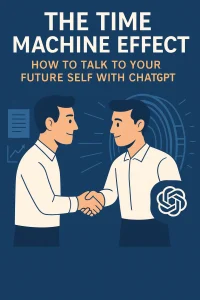TL;DR Instead of asking ChatGPT for tips how to do something, ask it to tell the story of how you already pulled it off. The result isn’t advice — it’s a concrete plan you can test today.
Most people treat ChatGPT like a search engine. You throw in a question, it spits out an answer, and you move on. That’s useful for quick lookups, but it leaves most of the real value on the table. The real breakthrough for me came when I stopped treating it as an encyclopedia and started treating it as a companion.
Here’s the trick: instead of asking “What is X?”, ask, “Assume I’ve already solved X — explain how I did it.”
Suddenly, ChatGPT stops being a dictionary and starts acting like an explanatory engine. It doesn’t just tell you what something is; it walks you through how you got there. It reverse-engineers the path to a declared outcome. And if you play along, that path often turns into a plan you can execute today.
Why the framing works
Think about the last time you tried to solve a tricky problem. Maybe you wanted to launch a side project, change careers, or finish that manuscript that’s been haunting you. When you’re standing at the starting line, the road ahead is foggy. Everything feels possible and impossible at the same time.
But if you flip the script — if you speak as though you’ve already reached the finish line — the fog clears. Your brain, and by extension ChatGPT, starts filling in the missing steps. Instead of “someday, maybe,” suddenly the fog lifts: you can see the sequence of events, the trade-offs you made, and even the stumbles you recovered from.
It’s not magic. It’s psychology. By distancing yourself from the present, you quiet the ego that usually says “my way is right.” By externalizing the story, you can see your thinking on paper instead of chasing it around in your head. And by forcing a causal chain, you get a roadmap that feels concrete instead of vague.
I call this blend of distance, externalization, and causality The Time Machine Effect.

A story: the “already-done” book launch
Let me show you what this looks like in practice.
Imagine you’re writing a book. You could ask ChatGPT the obvious question: “How do I launch a book?” And you’d get a sensible, if generic, answer: social media campaigns, preorders, reviews, the usual.
But here’s what happens when you use the Time Machine Effect instead.
I typed:
“Assume my book just hit #1 in India. Write the three-minute speech I gave, and the milestones I thanked my team for. Help me recall all steps that were taken to make this successful”
What came back wasn’t just a speech. Reading it felt uncanny — like I was remembering something I hadn’t lived yet. Hidden inside were the bones of a marketing plan: teaser essays published months in advance, a handful of early reviewers recruited from campus networks, a preorder push tied to small workshops, even a list of metrics to track each week.
None of this was revolutionary. But the format: looking back from the finish line — made the plan feel more real, more testable. I could immediately ask follow-ups like:
- Which of these steps is most likely to fail in the Indian market, and why?
- Translate these milestones into a week-by-week calendar with owners.
- Write the “we missed our target” note and list the five root causes.
Now I wasn’t just guessing anymore; I had a blueprint, a list of risks, and a timeline I could actually follow.
Why this feels different
Visualization is something we’ve all tried. You picture success in your head and hope it motivates you. The problem is: it vanishes the moment you get distracted.
The Time Machine Effect is different because it produces artefacts. You don’t just imagine a press release; you get a draft you can critique. You don’t just visualize a roadmap; you get a 12-week plan with gaps you can spot. The output is concrete enough to test and cheap enough to throw away if it doesn’t work.
That’s the key: it gives you something solid to wrestle with.
Try it for yourself
Pick one goal you’ve been circling. Instead of asking ChatGPT for tips, phrase it in the past tense. “It’s December 2025 and I’ve just pulled it off — explain how I did it.”
Push back on the answer. Add constraints. Ask it where the plan would fail. Demand alternatives. By the end of that loop, you’ll be holding a story of your own future — one you can start testing today.
If you give this experiment a shot, I’d love to hear in the comments how it worked out for you.
Final thoughts
ChatGPT’s real value isn’t that it “knows” more than you. It’s that it lets you hold onto your half-formed ideas long enough to shape them. The Time Machine Effect is how you turn those ideas into something sturdier: a story from the future that you can make real in the present.
So if you’ve only been using ChatGPT like a fancy Google, try this once. Pretend you’ve already succeeded. Ask it to explain how. Then bring that plan back, cut it down with reality, and run the first experiment.
You’ll be surprised at how fast fiction turns into action. The future you imagine doesn’t have to stay fiction. With the Time Machine Effect, you can start living it one small experiment at a time.
This article has also been published on our Medium page



